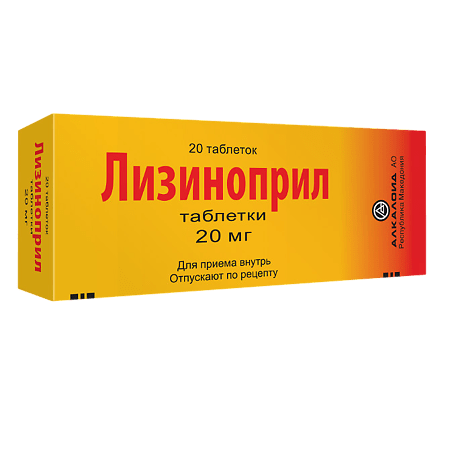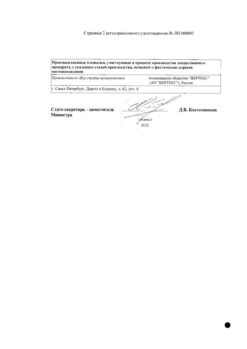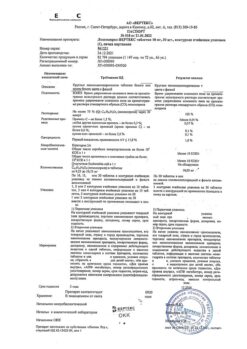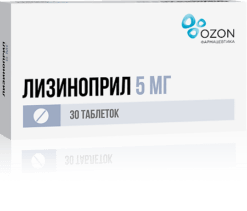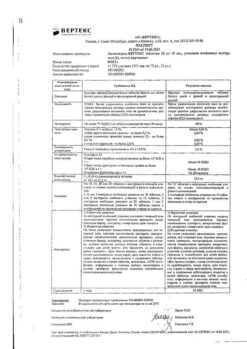No products in the cart.
Lisinopril, tablets 20 mg 20 pcs
€3.93 €3.49
Description
A ACE inhibitor, reduces the formation of angiotensin II from angiotensin I. Reduction of angiotensin II leads to a direct reduction of aldosterone release. Reduces bradykinin degradation and increases prostaglandin synthesis. Reduces total peripheral vascular resistance, blood pressure (BP), preload, pulmonary capillary pressure, causes an increase in the minute blood volume and increases myocardial exercise tolerance in patients with chronic heart failure.
Dilates arteries to a greater extent than veins. Some effects are explained by the effect on tissue renin-angiotensin systems. Long-term use reduces myocardial hypertrophy and resistive arterial wall hypertrophy. It improves the blood supply to the ischemic myocardium.
The ACE inhibitors prolong life expectancy in patients with chronic heart failure, slow the progression of left ventricular dysfunction in patients who have had myocardial infarction without clinical manifestations of heart failure. Antihypertensive effect starts after approximately 6 hours and lasts for 24 hours.
The duration of the effect also depends on the dose. The onset of action is in 1 hour. The maximum effect is determined after 6-7 hours. In case of arterial hypertension, the effect is noted in the first days after the start of treatment, the stable effect develops after 1-2 months. No pronounced increase in BP was observed when the drug was abruptly withdrawn.
In addition to BP reduction, lisinopril decreases albuminuria. In patients with hyperglycemia, it promotes normalization of function of damaged glomerular endothelium.
Lisinopril has no effect on blood glucose concentration in diabetic patients and does not lead to increased incidence of hypoglycemia.
Indications
Indications
Arterial hypertension (in monotherapy or in combination with other antihypertensive drugs);
Chronic heart failure (as part of combination therapy for the treatment of patients taking digitalis and/or diuretics);
Early treatment of acute myocardial infarction (in the first 24 hours with stable hemodynamic parameters to maintain these parameters and prevent left ventricular dysfunction and heart failure);
Diabetic nephropathy (reduction of albuminuria in insulin-dependent patients with normal blood pressure and non-insulin-dependent patients with arterial hypertension).
Pharmacological effect
Pharmacological effect
An ACE inhibitor, reduces the formation of angiotensin II from angiotensin I. A decrease in the content of angiotensin II leads to a direct decrease in the release of aldosterone. Reduces the degradation of bradykinin and increases the synthesis of prostaglandins. Reduces total peripheral vascular resistance, blood pressure (BP), preload, pressure in the pulmonary capillaries, causes an increase in minute blood volume and an increase in myocardial tolerance to stress in patients with chronic heart failure.
Dilates arteries more than veins. Some effects are explained by effects on tissue renin-angiotensin systems. With long-term use, hypertrophy of the myocardium and the walls of resistive arteries decreases. Improves blood supply to ischemic myocardium.
ACE inhibitors prolong life expectancy in patients with chronic heart failure and slow the progression of left ventricular dysfunction in patients who have suffered a myocardial infarction without clinical manifestations of heart failure. The antihypertensive effect begins after approximately 6 hours and lasts for 24 hours.
The duration of the effect also depends on the dose. The onset of action is after 1 hour. The maximum effect is determined after 6-7 hours. In case of arterial hypertension, the effect is observed in the first days after the start of treatment, a stable effect develops after 1-2 months. When the drug was abruptly discontinued, no pronounced increase in blood pressure was observed.
In addition to lowering blood pressure, lisinopril reduces albuminuria. In patients with hyperglycemia, it helps to normalize the function of damaged glomerular endothelium.
Lisinopril does not affect the concentration of glucose in the blood in patients with diabetes and does not lead to an increase in cases of hypoglycemia.
Special instructions
Special instructions
Symptomatic hypotension
Most often, a pronounced decrease in blood pressure occurs with a decrease in fluid volume caused by diuretic therapy, reducing the amount of salt in food, dialysis, diarrhea or vomiting. In patients with chronic heart failure with or without simultaneous renal failure, a pronounced decrease in blood pressure is possible. It is more often detected in patients with severe chronic heart failure, as a result of the use of large doses of diuretics, hyponatremia or impaired renal function. In such patients, treatment with lisinopril should be started under the strict supervision of a physician (with caution in selecting the dose of the drug and diuretics).
Similar rules must be followed when prescribing to patients with coronary heart disease or cerebrovascular insufficiency, in whom a sharp decrease in blood pressure can lead to myocardial infarction or stroke.
A transient hypotensive reaction is not a contraindication for taking the next dose of the drug.
When using lisinopril, some patients with chronic heart failure, but with normal or low blood pressure, may experience a decrease in blood pressure, which is usually not a reason to discontinue treatment.
Before starting treatment with lisinopril, if possible, the sodium concentration should be normalized and/or the lost fluid volume should be replaced, and the effect of the initial dose of lisinopril on the patient should be carefully monitored.
In case of renal artery stenosis (especially with bilateral stenosis, or in the presence of stenosis of the artery of a single kidney), as well as in circulatory failure due to lack of sodium and/or fluid, the use of lisinopril can lead to impaired renal function, acute renal failure, which is usually irreversible after discontinuation of the drug.
In acute myocardial infarction
The use of standard therapy (thrombolytics, acetylsalicylic acid, beta-blockers) is indicated. Lisinopril can be used in conjunction with intravenous administration or with the use of therapeutic transdermal nitroglycerin systems.
Surgery/general anesthesia
During extensive surgical interventions, as well as when using other drugs that cause a decrease in blood pressure, lisinopril, by blocking the formation of angiotensin II, can cause a pronounced, unpredictable decrease in blood pressure.
In elderly patients, the same dose leads to a higher concentration of the drug in the blood, so special care is required when determining the dose.
Since the potential risk of agranulocytosis cannot be excluded, periodic monitoring of the blood picture is required. When using the drug under dialysis conditions with a polyacryl-nitrile membrane, anaphylactic shock may occur, so either a different type of dialysis membrane or the prescription of other antihypertensive drugs is recommended.
Impact on the ability to drive vehicles and machinery
There is no data on the effect of lisinopril on the ability to drive vehicles and machines when used in therapeutic doses, however, it must be borne in mind that dizziness may occur, so caution should be exercised.
Active ingredient
Active ingredient
Lisinopril
Composition
Composition
One tablet contains:
active substance:
lisinopril dihydrate – 21.8 mg, which corresponds to 20 mg of lisinopril;
excipients:
lactose monohydrate (milk sugar) – 40.1 mg,
microcrystalline cellulose – 87.6 mg,
pregelatinized starch (starch 1500) – 44.0 mg,
colloidal silicon dioxide (Aerosil) – 0.5 mg,
talc – 4.0 mg,
magnesium stearate – 2.0 mg.
Contraindications
Contraindications
Hypersensitivity to lisinopril or other ACE inhibitors, a history of angioedema, including from the use of ACE inhibitors, hereditary angioedema, age under 18 years (efficacy and safety have not been established).
The tablets contain lactose; therefore, the drug should not be taken by patients with rare hereditary diseases such as galactose intolerance, lactase deficiency or glucose-galactose malabsorption.
WITH CAUTION
The drug is prescribed with caution in case of: severe renal dysfunction, bilateral renal artery stenosis or stenosis of the artery of a single kidney with progressive azotemia, condition after kidney transplantation, renal failure, azotemia, hyperkalemia, aortic stenosis, hypertrophic obstructive cardiomyopathy, primary hyperaldosteronism, arterial hypotension, cerebrovascular diseases (in including cerebrovascular insufficiency), coronary heart disease, coronary insufficiency, autoimmune systemic connective tissue diseases (including scleroderma, systemic lupus erythematosus); inhibition of bone marrow hematopoiesis; on a sodium-restricted diet: hypovolemic conditions (including as a result of diarrhea, vomiting); in old age.
Side Effects
Side Effects
The most common side effects: dizziness, headache (in 5-6% of patients), weakness, diarrhea, dry cough (3%), nausea, vomiting, orthostatic hypotension, skin rash, chest pain (1-3%).
Other side effects (frequency < 1%):
From the immune system: (0.1%) angioedema (face, lips, tongue, larynx or epiglottis, upper and lower extremities).
From the cardiovascular system: marked decrease in blood pressure, orthostatic hypotension, impaired renal function, cardiac arrhythmias, rapid heartbeat.
From the central nervous system: increased fatigue, drowsiness, convulsive twitching of the muscles of the limbs and lips.
From the hematopoietic system: possible leukopenia, neutropenia, agranulocytosis, thrombocytopenia, with long-term treatment – a slight decrease in the concentration of hemoglobin and hematocrit, erythrocytopenia.
Laboratory indicators: hyperkalemia, azotemia, hyperuricemia, hyperbilirubinemia, increased activity of liver enzymes, especially if there is a history of kidney disease, diabetes mellitus and renovascular hypertension.
Rare side effects (less than 1%):
From the cardiovascular system: palpitations; tachycardia; myocardial infarction; cerebrovascular stroke in patients with an increased risk of the disease due to a pronounced decrease in blood pressure.
From the digestive tract: dry mouth, anorexia, dyspepsia, changes in taste, abdominal pain, pancreatitis, hepatocellular or cholestatic jaundice, hepatitis.
From the skin: urticaria, increased sweating, itching, alopecia.
From the urinary system: impaired renal function, oliguria, anuria, acute renal failure, uremia, proteinuria.
From the immune system: a syndrome that includes accelerated erythrocyte sedimentation rate (ESR), arthralgia and the appearance of antinuclear antibodies.
From the central nervous system: asthenic syndrome, mood lability, confusion, decreased potency.
Other: myalgia, fever, impaired fetal development.
Interaction
Interaction
Lisinopril reduces the excretion of potassium from the body during treatment with diuretics.
Special caution is required when using the drug simultaneously with:
– potassium-sparing diuretics (spironolactone, triamterene, amiloride), potassium, table salt substitutes containing potassium (the risk of developing hyperkalemia increases, especially with impaired renal function), therefore they can be co-prescribed only on the basis of the individual decision of the attending physician with regular monitoring of potassium levels in the blood serum and renal function.
Can be used with caution together:
– with diuretics: with the additional administration of a diuretic to a patient taking lisinopril, as a rule, an additive antihypertensive effect occurs – the risk of a pronounced decrease in blood pressure;
– with other antihypertensive drugs (additive effect);
– with non-steroidal anti-inflammatory drugs (indomethacin, etc.), estrogens, as well as adrenergic stimulants – a decrease in the antihypertensive effect of lisinopril;
– with lithium (lithium excretion may decrease, so the concentration of lithium in the blood serum should be regularly monitored);
– with antacids and cholestyramine – reduce absorption in the gastrointestinal tract.
Alcohol enhances the effect of the drug.
Overdose
Overdose
Symptoms (occur when taking a single dose of 50 mg or higher): marked decrease in blood pressure; dry mouth, drowsiness, urinary retention, constipation, anxiety, increased irritability.
Treatment: symptomatic therapy, intravenous fluid administration, monitoring blood pressure, water and electrolyte balance and normalization of the latter.
Lisinopril can be removed from the body using hemodialysis.
Storage conditions
Storage conditions
Store at a temperature not exceeding 30°C.
Keep out of the reach of children.
Shelf life
Shelf life
3 years.
Manufacturer
Manufacturer
Alkaloid AD Skopje, Republic of North Macedonia
Additional information
| Shelf life | 3 years. |
|---|---|
| Conditions of storage | Store at the temperature not more than 30 ° C. Keep out of reach of children. |
| Manufacturer | Alkaloid AD Skopje, Republic of Northern Macedonia |
| Medication form | pills |
| Brand | Alkaloid AD Skopje |
Other forms…
Related products
Buy Lisinopril, tablets 20 mg 20 pcs with delivery to USA, UK, Europe and over 120 other countries.

